Many of the initiatives we are documenting and supporting look different from the dominant model of human rights advocacy that originated in the 1970s and proliferated in the 1990s and beyond. Nonetheless, they possess the common aim of assuring universal human dignity, which is at the core of human rights. Civil society initiatives go about that task in a variety of ways:
- Law-Based Human Rights Advocacy and Social Movements
Traditionally, the realization of human rights has depended in great measure on a combination of social movements and law-based advocacy. Human rights groups engaging in solidarity efforts across borders came to rely particularly on international human rights law, codified for the most part in international treaties adopted by member-states of the United Nations and other international and regional organizations. While the efforts of formally-organized human rights groups has always overlapped with more loosely-organized social movements, human rights groups became increasingly professionalized and came to rely on cross-border grant funding to financially sustain themselves.
- Civic Engagement and Public Participation
At the same time, formal civil society organizations (CSOs) developed to support citizen engagement in the growing number of countries which were adopting democratic political systems. As with law-based advocacy, the activities of these CSOs were intended to counter power dynamics that harmed the most vulnerable and politically marginalized citizens by broadening access to decision-making, ensuring democratic engagement and public participation by the entire society.
- Expanding Human Capabilities through Social Development
In parallel, CSOs working in the field of international development have supported vulnerable and socially marginalized people through pursuing a set of goals that were systematized by the UN in the form of Sustainable Development Goals (SDGs), covering matters as diverse as infant mortality and access to justice. As Amartya Sen theorized in his book Development as Freedom, the achievement of international development goals overlaps with human rights by improving the human capabilities that are a prerequisite for individuals to be able to exercise meaningful choices in how they lead their lives.
- Influencing Company Behavior by Leveraging Social Norms and Values
Finally, in more recent years, CSOs have begun to tackle the impact of corporate power on economically vulnerable and politically marginalized people. Trade unions have declined in influence and corporations have grown in size and ability to capture the state interests responsible for regulating them by law. As a result, some CSOs have begun to address alternative means to reign in corporate power through mobilizing stakeholders such as investors, business partners, employees and consumers on the basis of shared social norms and values.
All four of these approaches have one common denominator: they intend to protect vulnerable and politically marginalized people by addressing the power imbalances that harm them. Yet, it is an oversimplification to categorize individuals as vulnerable and marginalized, which are not immutable characteristics. Any person can experience harm from social, political and economic institutions. A broader way to describe what these approaches aim to achieve is to increase equity, inclusion, and agency in ways that can benefit anyone.
As a result, in our effort to map civil society innovation to advance human rights, we cover initiatives that set out to transform power dynamics in order to increase equity, inclusion, and agency through any of these related strategies:
- furthering law-based human rights advocacy,
- increasing social and political solidarity across borders,
- promoting civic engagement and public participation,
- expanding human capabilities through social development,
- influencing company behavior by leveraging social norms and values.
Photo by Maria Oswalt on Unsplash
